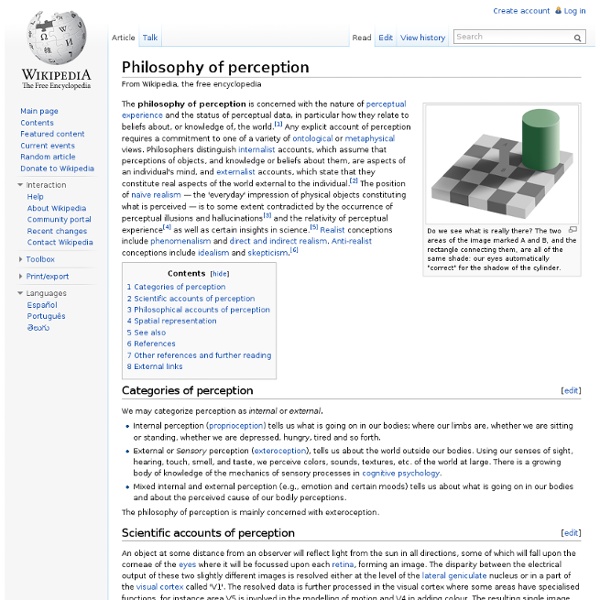Philosophy of science
Philosophy of science is a branch of philosophy concerned with the foundations, methods, and implications of science. The central questions concern what counts as science, the reliability of scientific theories, and the purpose of science. This discipline overlaps with metaphysics, ontology and epistemology, for example, when it explores the relationship between science and truth. There is no consensus on many central problems in philosophy of science, including whether science can reveal the truth about unobservable things and whether scientific reasoning can be justified at all. In addition to these general questions about science as a whole, philosophers of science consider problems that apply to particular sciences such as biology or physics. Some philosophers of science also use contemporary results in science to reach conclusions about philosophy. Today, some thinkers seek to ground science in axiomatic assumptions such as the uniformity of nature. Introduction[edit] History[edit]
Free stress help, mental health, self-help, depression, anxiety, online counseling, internet counseling, free counseling, CBT, REBT, Rational Emotive Therapy, cognitive behavioral therapy, ABC worksheet, herbal supplements, herbs depression, anger managme
Epistemological Problems of Perception
First published Thu Jul 12, 2001; substantive revision Sat May 5, 2007 The historically most central epistemological issue concerning perception, to which this article will be almost entirely devoted, is whether and how beliefs about physical objects and about the physical world generally can be justified or warranted on the basis of sensory or perceptual experience—where it is internalist justification, roughly having a reason to think that the belief in question is true, that is mainly in question (see the entry internalist vs. externalist conceptions of epistemic justification). This issue, commonly referred to as “the problem of the external world,” divides into two closely related sub-issues, which correspond to the first two main sections below. 1. What is it that we are immediately or directly aware of in sensory or perceptual experience? 1.1 The idea of immediacy or givenness 1.2 The Sense-Datum Theory Two main arguments have been offered for the sense-datum view.
Philosophy of religion
Philosophy of religion is a branch of philosophy concerned with questions regarding religion, including the nature and existence of God, the examination of religious experience, analysis of religious vocabulary and texts, and the relationship of religion and science.[1] It is an ancient discipline, being found in the earliest known manuscripts concerning philosophy, and relates to many other branches of philosophy and general thought, including metaphysics, logic, and history.[2] Philosophy of religion is frequently discussed outside of academia through popular books and debates, mostly regarding the existence of God and problem of evil. The philosophy of religion differs from religious philosophy in that it seeks to discuss questions regarding the nature of religion as a whole, rather than examining the problems brought forth by a particular belief system. It is designed such that it can be carried out dispassionately by those who identify as believers or non-believers.[3] [edit] Aquinas
The Science of Stress, Orgasm and Creativity: How the Brain and the Vagina Conspire in Consciousness
“The more closely we analyze what we consider ‘sexy,’” philosopher Alain de Botton argued in his meditation on sex, “the more clearly we will understand that eroticism is the feeling of excitement we experience at finding another human being who shares our values and our sense of the meaning of existence.” But in his attempt to counter the reductionism that frames human sexuality as a mere physiological phenomenon driven solely by our evolutionary biology, de Botton overcompensates by reducing in the opposite direction, negating the complex interplay of brain and biology, psychology and physiology, that propels the human sexual experience. That’s precisely what Naomi Wolf, author of the 1991 cultural classic The Beauty Myth, examines in Vagina: A New Biography (public library) — a fascinating exploration of the science behind the vastly misunderstood mind-body connection between brain and genitalia, consciousness and sexuality, the poetic and the scientific. Wolf writes:
Temas de Psicología. Neurosis obsesivo-compulsiva
En el apartado «Obsesiones-compulsiones» se detalla su concepto y forma de manifestación. El enfermo vive tanto la obsesión (pensamiento que no se puede desechar) como la compulsión (acto que el sujeto se ve obligado a realizar) como órdenes que siente surgir dentro de sí mismo y que debe obedecer pese a que las considera absurdas, patológicas, anormales y perjudiciales; si se resiste nota una angustia creciente hasta que tiene que ceder. Las obsesiones y las compulsiones se dan combinadas en la misma persona formando la «neurosis obsesivo-compulsiva», aunque en un enfermo determinado puedan dominar claramente síntomas de uno de los dos tipos. ¿Tiene el individuo normal obsesiones y compulsiones? Igual que los restantes síntomas neuróticos, las obsesiones y las compulsiones aparecen, dentro de cierta medida, en casi todas las personas. Uno de los aspectos más frecuentes de las obsesiones y compulsiones es el carácter de duda patológica. Cuadro clínico de la neurosis obsesivo-compulsiva.
Ancient Philosophy
Personality Types
Whether you are searching for the ideal date or marriage partner or just someone to work for you part-time, identifying ideal personality traits is key to successful relationships. Listen to the words below and consult a dictionary if you need a definition. Write a sample sentence for each word to learn how it is used in context. You can use the Internet to find such sentences. [ Other Audio Options: Play RealMedia | Play Window Media ] ambitious - unmotivated generous - stingy hardworking - lazy honest - dishonest humble - bigheaded independent - dependent kind - inconsiderate nervous - calm open-minded - close-minded optimistic - pessimistic outgoing - shy punctual - late reliable - unreliable talkative - quiet unselfish - self-centered I like someone who is ___________ because ________. Now, complete the sentences below with the best answer: Think of three things to describe the ideal boss, roommate, and partner.
Significado.
Modern Philosophy



